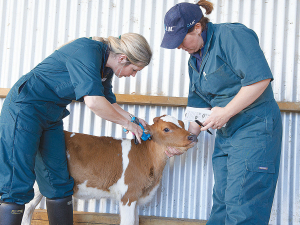2024/25 Dairy Statistics: NZ dairy farmers boost production with fewer cows
According to the New Zealand Dairy Statistics 2024/25 report, New Zealand dairy farmers are achieving more with fewer cows.
 For the sake of convenience and efficiency, tissue sampling calves for the BVD test can be combined with tagging or disbudding.
For the sake of convenience and efficiency, tissue sampling calves for the BVD test can be combined with tagging or disbudding.
This calving season, LIC is offering a BVD test for newborn calves to provide farmers with an early indication on the health status of their valuable replacement stock.
Previously, farmers who were testing their calves for BVD through LIC were required to wait until calves were at least 35-days-old befor being able to confirm the BVD status of the newborns.
BVD is a common, highly infectious disease that reduces milk production and causes health and fertility problems. Estimates put the annual losses for dairy farmers at around $127 million a year.
The disease is spread by carriers, also known as persistently infected (PI) animals, who are born with the virus in their body.
Malcolm Ellis, LIC general manager New Zealand markets, says eliminating the the 35 day delay before being able to test a calf for BVD will significantly improve a farmer's ability to manage the disease as well as add a layer of convenience on-farm as a result of conducting the test at such a young age.
"PI animals can cause havoc on the health status of the wider herd. Knowing the BVD status of your calves as early as possible will significantly reduce the risk of them passing the virus on to the rest of the herd."
Ellis highlights an additional benefit of the new test is the ability to couple it with other tasks happening on-farm at the same time.
"For the sake of convenience and efficiency, tissue sampling calves for the BVD test can be combined with tagging ot disbudding."
The new BVD test for calves was successfully piloted last year with the product offered to a limited number of customers.
Ellis says the co-op is committed to using its capabilities to develop new products and services that drive long term customer value on-farm.
"Value for our farmer shareholders is at the heart of what we do. Our diagnostics product suit supports armers to produce the most sustainable and efficient animals."
Primary sector leaders have welcomed the announcement of a Free Trade Agreement between India and New Zealand.
|
A landmark moment for New Zealand. That's how Prime Minister Christopher Luxon describes the conclusion of negotiations for an India-New Zealand Free Trade Agreement. Beef Progeny Test 2025: Genetic insights for NZ beef industryAt Pāmu’s Kepler Farm in Manapouri, mating has wrapped up at the across-breed Beef Progeny Test. HortNZ celebrates 20 YearsMore than 150 people turned up at Parliament recently to celebrate the 20th anniversary of Horticulture New Zealand (HortNZ). Biosecurity NZ urges vigilance for yellow-legged hornetsBiosecurity New Zealand says Kiwis should continue to keep an eye out for yellow-legged hornets (Vespa velutina) over the holiday season. Mental Health and Fitness Unite: The Push-Up Challenge comes to New ZealandThe Push-Up Challenge, an event which combines mental health and fitness, is set to launch in New Zealand in 2026. NationalFonterra capital return could boost GDP – ANZ ReportThe Fonterra divestment capital return should provide “a tailwind to GDP growth” next year, according to a new ANZ NZ report,…Fonterra upgrades Eltham cheese production for global growthFonterra's Eltham site in Taranaki is stepping up its global impact with an upgrade to its processed cheese production lines,…Michelle Pye elected to Fonterra boardCanterbury farmer Michelle Pye has been elected to Fonterra’s board for a three-year term.Government plan to scrap regional councils faces criticismGovernment plans to get rid of regional councillors shows a lack of understanding of the fundamental problem affecting all of…Lactose to join fat and protein in Fonterra milk price modelFor over 20 years, Whakatane farmer Gerard Van Beek has been attending Fonterra annual general meetings with the same message…Machinery & ProductsCase IH Unveils New RB6 Round Balers & 2026 Square Baler UpgradesCase IH has released details of its all-new round balers and redesigns to its large square balers aimed at increasing…How to Improve Milking Efficiency in Swing-Over Herringbone ShedsThe swing-over herringbone is the most common dairy type in New Zealand, used on 69% of dairy farms. Simple changes…Claas Jaguar 1000 Series sets new forage harvesting world recordThe recently released Claas Jaguar 1000 Series has seen its flagship 1200 set a new official Guiness World Record in…CB Norwood appoints John Skurr as new general managerCB Norwood Distributors Limited has announced the appointment of John Skurr to the position of general manager.AIMER, Bovonic and Herd-i join forces to advance NZ dairy techThree New Zealand agritech companies are set to join forces to help unlock the full potential of technology.» Latest Print Issues OnlineMilking ItTrump's tariffsPresident Donald Trump’s decision to impose tariffs on imports into the US is doing good things for global trade, according… Tanker on the rollSeen a giant cheese roll rolling along Southland’s roads? » eNewsletter |